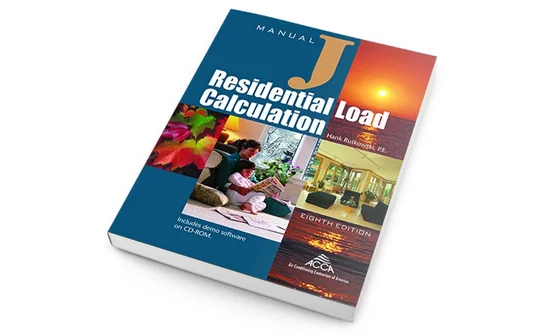Comfort is king, and accurately sizing an HVAC system is essential for optimal comfort, energy efficiency, and cost-effectiveness. With building codes and incentive programs increasingly requiring Manual J calculations for HVAC retrofits, it’s never too early to remember the HVAC sizing techniques according to ACCA Manual J
Understanding ACCA Manual J:
The Air Conditioning Contractors of America (ACCA) developed Manual J, a widely accepted standard for HVAC load calculations. ACCA Manual J outlines the procedures for calculating the heating and cooling loads of residential buildings. ACCA Manual J enables accurate determination of the capacity and size of HVAC equipment needed to maintain comfortable indoor conditions by taking into account various factors, including climate zone, insulation levels, window properties, and occupancy patterns.
Why Load Calculations Matter:
Sizing is critical for all heating and cooling systems to achieve optimal comfort, energy efficiency, and equipment longevity. Oversized HVAC systems may cycle on and off frequently, leading to energy waste, uncomfortable temperature swings, increased wear and tear on equipment, and reduced moisture removal. Undersized systems, on the other hand, may struggle to maintain desired indoor conditions.
The Three Steps to ACCA Manual J:
1.Gathering the necessary input data:
The saying “garbage in, garbage out” is particularly true when it comes to any load calculation. To get to an accurate load calculation, a HVAC pro must collect the following information:
- Building dimensions and orientation: While laser tape measures are most commonly used, LiDAR-based software can enable a rapid understanding of home dimensions.
- Insulation levels in walls, ceilings, and floors; air sealing of attics and basements: evaluating insulation levels through observation of insulation types and depths is important as a baseline for heat transfer.
- Window types, sizes, and orientation: evaluating the window’s composition (e.g., number of panes and coating), as well as the size and directions are critical to understanding the solar heat gain stemming from windows>.
- Infiltration rates and air leakage of the home: evaluating using a thermal imaging camera or blower door test often will yield the most accurate results.
- Occupancy schedules and internal heat gains: observing the different appliances and equipment, as well as understanding occupancy levels from homeowners, are important inputs to understand additional sources of heat in the home.
- Climate data for the region: simple lookups into the region’s ASHRAE data can help identify the design conditions for which a system is sized.
2. Conducting the Load Calculation:
The ACCA Manual J textbook is by no means short - the detailed procedures for load calculations spans hundreds of pages, to adequately take into account heat gains and losses from various sources, including:
- Conduction: Heat transfer through the building envelope.
- Infiltration: Uncontrolled air leakage from the outside.
- Ventilation: Controlled air exchange for indoor air quality.
- Internal Loads: Heat generated by occupants, appliances, and lighting.
For this, among many reasons, Manual J software tools are imperative to simplify the process and ensure accurate results, and reduce the complexity required for load sizing. Using software like Conduit Tech’s can bring this process down to 15 minutes or less - depending on your unique insights on the building and the customer experience, but leaving the calculations to a simple iPad application.
3. Using your results:
Sizing is critical - but ACCA Manual J also emphasizes the importance of properly sizing the ductwork and selecting appropriate equipment. Oversized or undersized ducts can adversely affect system performance, leading to air distribution issues and reduced efficiency. Manual D provides guidance on duct sizing and selection, taking into account the system's capacity and the airflow requirements of each room. Similarly, ensuring the right equipment through the Manual S process, is critical to make sure you can deliver the identified loads.
Conclusion:
We’re all motivated to deliver the best comfort and efficiency for every home served. Following the guidelines set forth by ACCA Manual J ensures that HVAC professionals can calculate the appropriate heating and cooling loads, and set the path for selecting the right equipment.
If you're interested in learning more about load calculations, or software to help you navigate them, reach out or book a time directly with our team at Conduit Tech.

